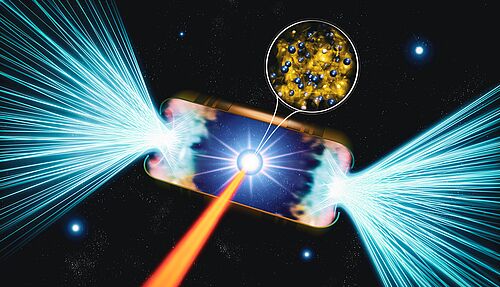The international research team utilized the world's largest and most energetic laser, the National Ignition Facility (NIF), to generate the extreme conditions necessary for pressure-driven ionization. By employing 184 laser beams, the team heated the inside of a cavity, converting the laser energy into X-rays that heated a 2 mm diameter beryllium shell placed in the center. As the outside of the shell rapidly expanded due to the heating, the inside accelerated inwards reaching temperatures around two million kelvins and pressures up to three billion atmospheres, creating a tiny piece of matter as found in dwarf stars for a few nanoseconds in the laboratory.
The highly compressed beryllium sample, up to 30 times its ambient solid density, was probed using X-ray Thomson scattering to infer its density, temperature, and electron structure. The findings revealed that, following strong heating and compression, at least three out of four electrons in beryllium transitioned into conducting states. Additionally, the study uncovered unexpectedly weak elastic scattering, indicating reduced localization of the remaining electron.
Matter in the interior of giant planets and some relatively cool stars is highly compressed by the weight of the layers above. At such high pressures, generated by high compression, the proximity of atomic nuclei leads to interactions between electronic bound states of neighboring ions and ultimately to their complete ionization. While ionization in burning stars is primarily determined by temperature, pressure-driven ionization dominates in cooler objects.
"The degree of ionization of atoms inside stars is crucial for how effectively energy can be transported from the center to the outside by radiation. If this is too severely restricted, it becomes turbulent in the celestial bodies, similar to a saucepan," explains Dominik Kraus, who was still working in California at the beginning of the project and is now a physics professor at the University of Rostock and a group leader at HZDR. "If it's too turbulent, life as we know it might not be possible in close orbit around small stars."
Despite its importance for the structure and evolution of celestial objects, pressure ionization as a pathway to highly ionized matter is not well understood theoretically. Moreover, the extreme states of matter required are very difficult to create and study in the laboratory, said LLNL physicist and alumnus of the University of Rostock Tilo Döppner, who led the project. “Our work opens new avenues for studying and modeling the behavior of matter under extreme compression. The ionization in dense plasmas is a key parameter as it affects the equation of state, thermodynamic properties, and radiation transport through opacity.”
The research also has significant implications for inertial confinement fusion experiments at the NIF, where X-ray absorption and compressibility are key parameters for optimizing high performance fusion experiments. A comprehensive understanding of pressure- and temperature-driven ionization is essential for modeling compressed materials and ultimately for developing an abundant, carbon-free energy source by means of laser-driven nuclear fusion, Döppner added.
“The groundbreaking results were also made possible by the dedicated work of doctoral students at the University of Rostock and at the Helmholtz-Zentrum Dresden-Rossendorf, some of whom have completed research stays at the NIF in California,” reports Ronald Redmer, physics professor at the University of Rostock and expert in the theoretical description of dense astrophysical plasmas. “The evaluation of the results from the complicated experimental setup and the modeling of the investigated plasma states is highly complex and requires an enormous amount of computing power. It has taken several years to reach the current understanding of the experimental data.”
The researchers also hope to gain further insights into matter at pressures of billions of atmospheres from a facility in Germany. With the help of the Helmholtz International Beamline for Extreme Fields (HIBEF) at the European XFEL in Schenefeld, scientists from the University of Rostock and the Helmholtz-Zentrum Dresden-Rossendorf want to achieve similar conditions on a much smaller scale. This would enable substantially more experiments than is currently possible at the NIF.
The pioneering research was the result of an international collaboration to develop x-ray Thomson scattering at the NIF as part of LLNL’s Discovery Science program. Collaborators included scientists from SLAC National Accelerator Laboratory, University of California Berkeley, University of Rostock (Germany), University of Warwick (U.K.), GSI Helmholtz Center for Heavy Ion Research (Germany), Helmholtz-Zentrum Dresden-Rossendorf (Germany), École normale supérieure de Lyon (France), Los Alamos National Laboratory, Imperial College London (U.K.), and First Light Fusion Ltd. (U.K.).
Link to the LLNL news article: https://www.llnl.gov/news/experiments-shed-light-pressure-driven-ionization-giant-planets-stars
Publication reference:
T. Döppner, M. Bethkenhagen, D. Kraus, P. Neumayer, D. A. Chapman, B. Bachmann, R. A. Baggott, M. P. Böhme, L. Divol, R. W. Falcone, L. B. Fletcher, O. L. Landen, M. J. MacDonald, A. M. Saunders, M. Schörner, P. A. Sterne, J. Vorberger, B. B. L. Witte, A. Yi, R. Redmer, S. H. Glenzer, D. O. Gericke, Observing the onset of pressure-driven K-shell delocalization, Nature, 2023 (DOI: 10.1038/s41586-023-05996-8)
Contact information:
Prof. Dr. Dominik Kraus
University of Rostock
Institute for Physics
High Energy Density Physics
phone: +49 381 498-6930
dominik.kraus@uni-rostock.de

